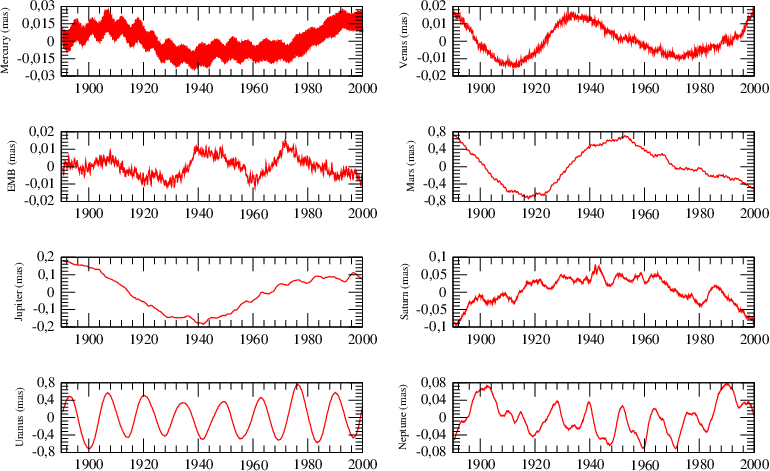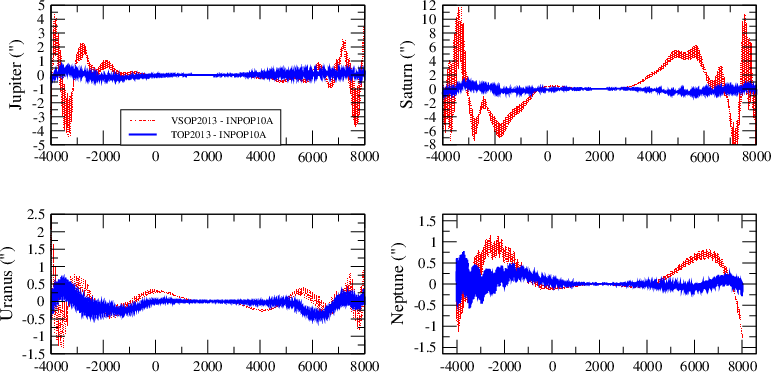Analytical Planetary Theories
Introduction
For the last 30 years, two kinds of analytical planetary theories have been built in the IMCCE: the VSOP (Variations Séculaires des Orbites Planétaires) theories, essentially issued from the research works of P. Bretagnon, and the TOP (Theory of Outer Planets) theories, derived from the works of J.-L. Simon. The VSOP theories are solutions for the motion of the eight planets in the solar system ; they are very precise over a time span of about 1000 years and the ephemerides published by the IMCCE from 1984 to 2006 were derived from VSOP. The TOP theories are solutions for the motion of the four major planets and are accurate over several thousands of years. Currently, the ephemerides of the planets are obtained mainly from very precise numerical integrations fitted to the most recent observations. Nevertheless, the construction of analytical planetary theories remains useful:
- Even if the aim of analytical theories is not to compete with numerical integrations for space engineering, they can provide precise ephemerides for the concern of most astronomers
- Their precision slowly decrease with time and they remain accurate over several thousand years
- They allow a precise analysis of the perturbations
- They are useful for some problems such as the study of the Earth’s rotation
- From these theories it is possible to obtain compact solutions of good precision
New planetary theories
The last analytical planetary theories built in the IMCCE are the VSOP2013 and TOP2013 solutions (Simon, Francou et al. A&A, 2013). These theories are build by iterative methods and fitted to the numerical integration INPOP10a (Fienga et al. A&A, 2011). They contain the analytical perturbations of the asteroids considered by INPOP10A and the analytical perturbations due to the Pluto-Charon barycenter. VSOP2013 is a solution of the equations of the motion of the eight solar system planets where relativistic corrections are introduced in the iterations. Variables are developed under the form of Poisson series of the mean mean longitudes of the perturbating bodies and of the lunar aguments. VSOP2013 is the best analytical theory for the motion of the eight solar system planets over time spans of a few hundred years and for the motion of the telluric planets over large time spans. The differences between VSOP2013 and INPOP10a for the mean longitudes of the planets from 1890 to 2000 are illusted by fig. 1. These differences are about a few 0.01 mas for Mercury, Venus, EMB, Saturn and Neptune, 0.2 mas for Jupiter and 0.7 mas for Mars and Uranus.

TOP2013 is a theory of the motion of the four major planets anf of the Pluto-Charon barycenter. Variables are developed under the form of Poisson series of only one argument. Using this representation, perturbations are more convergent than the classical form for Jupiter and Saturn. TOP2013 is the most precise theory for the motion of the four major planets over large time spans ; it also gives a solution of the motion of the Pluto- Charon barycenter with good accuracy up to time spans of a few hundred years. The differences between TOP2013, VSOP2013 and INPOP10a for the heliocentric longitudes of the major planets from −4000 to 8000 are illusted by fig. 2. For TOP2013, these differences are between 0.4″ (Jupiter) et 0.9″ (Saturne).

Methods used to build the IMCCE planetary theories
With G. Francou, we have published (Simon and Francou, 2016) a scientific note wich details the formulars used to build the IMCCE planetary theories, the methods used and the computer programmes developed by the authors (P. Bretagnon, J.-L. Simon, G. Francou). Moreover, this note gives the procedure to actually build these solutions. At the present time we gather together the computer programmes allowing to build these solutions in two derectories CONSTRUCTION VSOP and CONSTRUCTION TOP which will be made available to users.
References
- Simon, J.-L., Francou, G.: Construction des théories planétaires de l’IMCCE, Note scientifique et technique de l’IMCCE S103
- Simon, J.-L., Francou, G., Fienga, A., Manche, H.: 2013, New analytical planetary theories VSOP2013 and TOP2013, Astron. Astrophys. 557, A49
- Fienga, A., Laskar, J., Kuchynka, P., Manche, H., Desvignes, G., Gastineau, M., Cognard, I., Theureau, G .: 2011, The INPOP10a planetary ephemeris and its applications in fundamental physics, Celest. Mech. Dyn. Astron. 111, 363.3
Last update Friday 19 June 2020